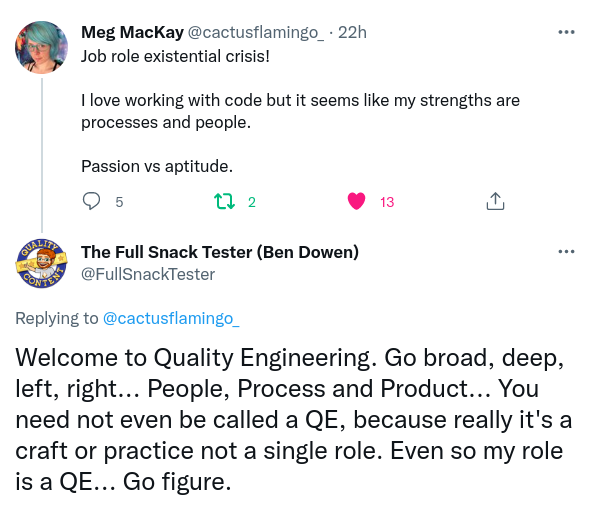Building your toolbox and sharpening your tools
Too long, didn’t read:
- Tools can include mental models, methods or software
- Get inspired by following people on social media, read blogs and attend conferences
- Learn new tools from resources such as presentations, blogs. books, tutorials and courses
- Create regular opportunities to practice using tools, so you can be comfortable using them and even teaching others
Quality Engineering
Tester? Quality Engineer? QA? There are many named roles in Software Testing, that can imply different work and scope, but often involve some of the same core skills.
What is your bag? People, Process, or Product? This is the question that has led Meg to have a Job role existential crisis!
In response I gleefully welcome Meg to my world, where I attempt to blend all of these things into my current role as a Quality Engineer.
https://twitter.com/FullSnackTester/status/1529206878793871361
Think about this a bit more, what did I mean and how can it be helpful for others?
Build your toolbox
As I have grown in software testing over my career, I like to think I’ve made progress becoming a better Tester. A large part of what that means to me, is that I have expanded my toolbox. I know more ways to solve problems, so not every problem looks like a nail and I reach for my hammer less and less.
What are tools?
In this context, as well as software tools such as Postman, I also mean thinking tools like MindMaps, and techniques like Exploratory Testing.
If you want a toolbox that covers People, Process and Product, you will need to collect a broad range of tools.
Learn from resources
The primary way to learn new things, is to start by consuming resources. You may already be familiar with learning from Books, Courses, Blogs and other resources.
Resources I’ve learned from include:
- [Book] Explore It! - Elisabeth Hendrickson
- [Course] Test Automation University
- [Blog] QA Hiccupps - James Thomas
- [Blog] A Tester’s Journey - Lisi Hocke
- [Newsletter] Software Testing Weekly
Learn by experimentation
Another excellent way of learning new tools, techniques and methods I’ve used is by finding opportunities to try things out.
By running short experiments, we can quickly find out if something is worth further effort to learn deeper. While I have tried out many tools and run many short experiments, I don’t have a useful example to share.
Sharpen your tools
Now you know a bunch of new things, you have new tools in your toolbox! This is a great start, because it expands your knowledge base and helps you choose more specific tools for the problems you encounter.
What I find, is that however much knowledge I consume, however much theory I ingest, I don’t feel comfortable using tools until I’ve spent a good amount of time being uncomfortable and practice using them.
Around the start of the year I had done some good learning Exploratory Testing form resources, but I was not comfortable using it regularly.
In order to sharpen my Exploratory Testing skills I setup regular sessions to practice, every week and on the software my team is working on. This worked better then I hoped, and I am now comfortable Exploring and working with others introduce them to the method.
In summary: Create regular opportunities to practice using tools.
